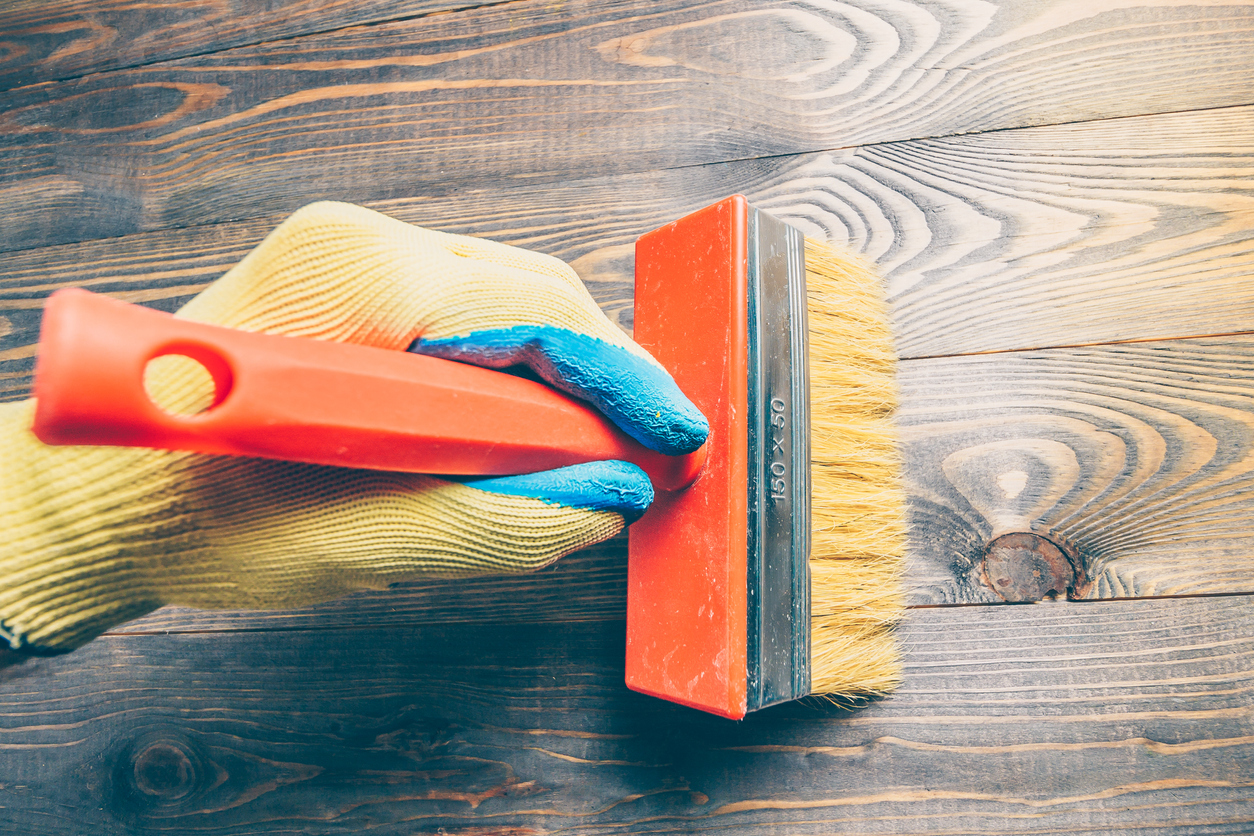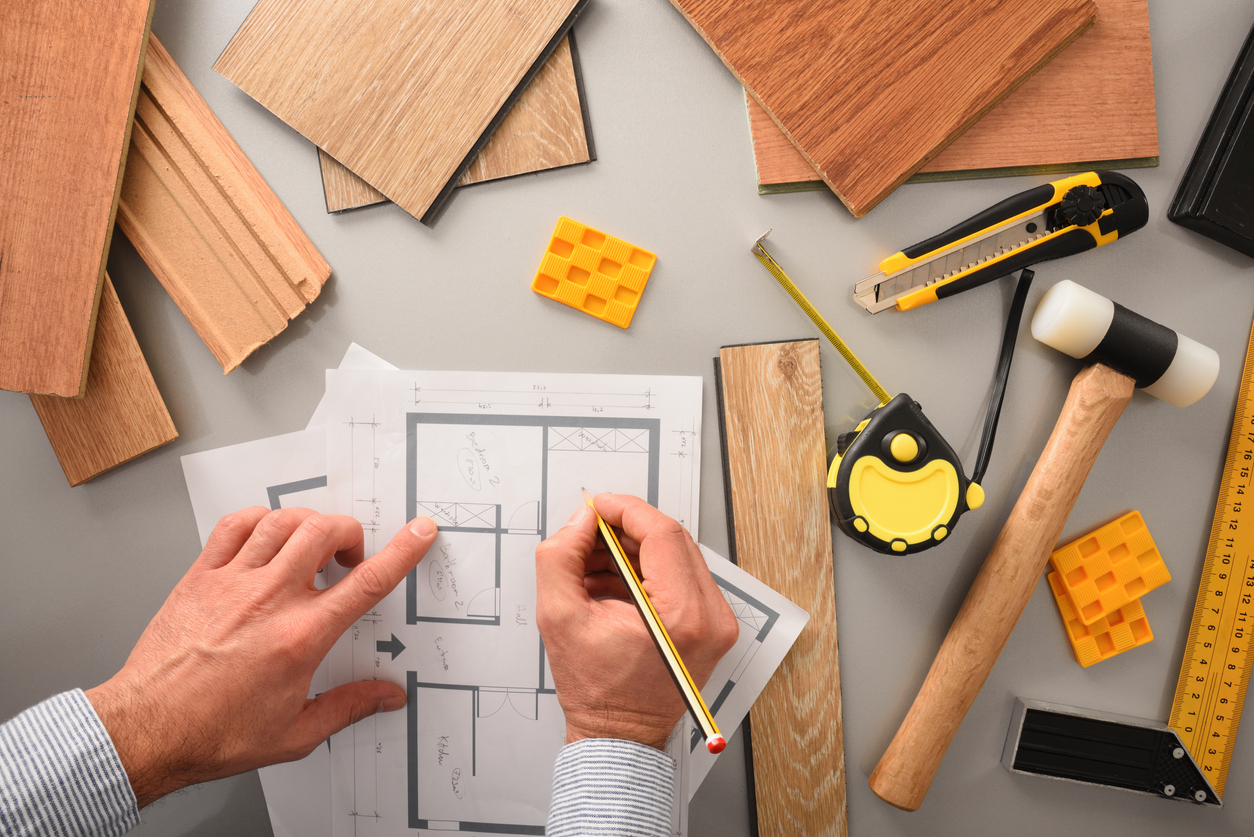We may earn revenue from the products available on this page and participate in affiliate programs. Learn More ›
Q: Recently my living room floor has started squeaking in several places. I’m not sure how long this has been going on, but now that I’ve noticed it, the sound is driving me crazy! How do I find out who to hire to fix squeaky floors?
A: Floors that squeak when they are walked on are far from uncommon, but that doesn’t make them any less annoying. Squeaking is a problem that can affect carpet, laminate flooring, hardwoods, and other materials. It can sometimes be attributed to the subfloor rather than floorboards on the surface. While some homeowners may call a handyman or contractor to fix squeaky floors, it’s generally a good idea to hire a local flooring company for this repair. Whether the culprit is a single warped board or an entire damaged subfloor, one of the best flooring companies will be able to find the right solution. There are even a few simple fixes that handy homeowners may be able to perform themselves. Read on to learn more about who to hire to fix squeaky floors, as well as some of the most common repairs.
Squeaking floors can have several causes.
The nature of the repair will depend on what is causing squeaky floors in the first place. Here are some common issues.
- Board to board: When wood floors are installed, the planks are attached to the subfloor with nails. Over time, the nails can loosen and boards may begin to separate from the subfloor. This can cause the planks to squeak as they rub against one another.
- Subfloor: The subfloor is a base beneath the floorboards or carpet that lays on top of a series of joists. A worn or poorly installed subfloor can cause large portions of the floor to squeak. It is also common for the squeaking to come from the joists, which may be loose or incorrectly spaced.
- Hardwood on concrete: Instead of being attached to a subfloor, some hardwoods are glued directly onto a concrete surface. If the planks are installed on a concrete slab that is not level, the boards can squeak in areas where there are gaps between the hardwood and the concrete.
- Humidity: Wood is porous, and wooden floors are prone to absorbing excess moisture from the air. As the planks expand, they can start to rub together and squeak. This is most common in the summer when it is humid. In some cases, the squeaking may stop when conditions become less damp. If humidity is a year-round issue, it may be worth it to install a dehumidifier in the room with the squeaky floor.
- Cold weather: In contrast to summer humidity, winter typically brings drier conditions. Dry air draws moisture out of the floorboards, causing them to shrink. The excess of space gives the boards more room to move when walked on, resulting in squeaking.
If a basement or crawl space can be accessed, repairs to the subfloor can be made from below.
For those who don’t already know how to fix squeaky floors, it can be done a few different ways depending on the nature of the problem. Whether a professional will handle the project or you are attempting a DIY fix, most repairs can be performed from underneath by entering the crawl space. Here are some options to fix a squeaky floor from below.

- Use a shim: If there are significant gaps between the subfloor and joists, using a shim or a wedge to fill the space can eliminate squeaking. A wooden wedge can be inserted into the space using a hammer or mallet wherever squeaking is noticed.
- Use a Squeak-Ender: While shims eliminate gaps by filling them, Squeak-Enders take the opposite approach. They are made up of a long bolt and a bracket piece that work together to push the joist back up toward the subfloor for extra support.
- Use construction adhesive: A shim or Squeak-Ender will work well for small gaps, but a longer gap will require a different solution. Construction adhesive can be piped into gaps that are ¼-inch or smaller in width for the same effect. DIYers will want to be sure that there is plenty of ventilation in the space, as the fumes from the adhesive can be toxic.
- Nail or glue the board: If the joist needs additional support, it’s possible to nail or glue a 2×4 plank against the joists for reinforcement. Repeat this wherever squeaking is an issue.
- Drive screws through the subfloor: If there are gaps between the subfloor and hardwoods, use a short screw to bring them back together. The screw should not be long enough to penetrate the floor’s surface. It’s a good idea to test this in a part of the room where people will not step on the floor with bare feet.
Securing or lubricating the floorboards can be done from above.
If it’s not possible to access the subfloor via the crawl space, there are still some solutions for repairing the floor from the surface without fancy wood-turning tools or advanced knowledge in woodworking.

- Screw or nail through the floor: This option works well for carpeted rooms where the subfloor is accessible without causing damage to its surface. After locating where the squeaky area is, pull up the carpet and use a stud sensor to determine where the subfloor meets the joist below. Then, nail or screw the subfloor to the joist and lay the carpet back down.
- Lubricate the floorboards: Squeaky wood floors may be temporarily silenced by applying WD-40 or a floor lubricant product between the boards. However, the lubricant may need to be reapplied frequently and will likely not be the most practical solution for more than one or two boards. Also keep in mind that this will not work if the subfloor is the root of the problem.
A local flooring company can fix squeaky floorboards.
Most often, flooring companies are the best option for squeaky floor repair. If the floor is old or the squeaking is affecting more than one or two boards, extensive repairs may be necessary. Professional flooring contractors are best equipped to diagnose the issue, provide a quote, and start working as quickly as possible. This efficiency can also result in lower repair costs, since the labor will take less time and the company will already have all the necessary equipment on hand.
It’s not uncommon to hire a handyman to fix squeaky floors when the problem is limited to a small area. However, a handyman may be unable to handle a more complex job. When in doubt, it’s a good idea to reach out to a squeaky floor repair contractor to find the best solutions.
Squeaky floor repairs cost as little as $200 or as much as $1,000 for more significant repairs.
The biggest factors in determining what homeowners pay for squeaky floor repair are the extent of the problem and how easy it is to access the subfloor. The price to repair one or two boards will likely fall around $200, especially if the subfloor can be examined easily from the home’s crawl space or basement. On the other hand, if the entire subfloor needs to be repaired or replaced, it’s likely that the total cost will be closer to $1,000.

Sometimes squeaking floors are the result of water damage. Depending on how much of the floor has been affected, it can cost up to $5,000 to restore a floor that has significant water damage. Homeowners may also pay more for hardwood floor repairs than to fix a squeaky floor under carpet if the repair includes drilling into the boards from the surface. This is because the area will need to be refinished to cover any holes rather than being concealed with carpeting. It’s wise to contact more than one flooring company for quotes in order to get the best available price.

Carpet, hardwood, tile, vinyl, and laminate flooring.
Bob Vila has partnered with Empire Today® to help you easily get beautiful new floors at a great price.
Free In-Home Estimates
Homeowners can minimize the risk of floors squeaking in the future.
While squeaking floors are often the result of old age and normal wear, there are plenty of ways to prolong the time between repairs. Regular maintenance such as cleaning and polishing hardwoods can prevent dust and dirt from collecting in the seams. Spills or leaks should be cleaned up immediately as the boards or subfloor can become warped.
It’s also recommended to keep the home’s climate stable and controlled—too much moisture in the air or drastic temperature changes can cause the floor to swell or shrink, resulting in squeaking. Flooring in rooms that get a lot of natural light may suffer from UV exposure, which can also cause them to age prematurely.
A lesser-known cause of squeaking floors is vibrating appliances, which can loosen the flooring over time. Washers and dryers can be placed on rubber pads to absorb some of the vibration, but for best results, these appliances should be placed on concrete or other solid flooring.
Sources: HomeAdvisor


